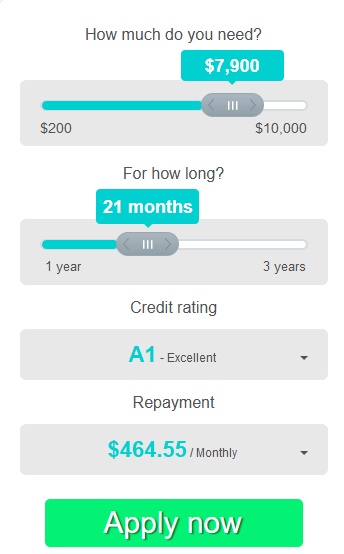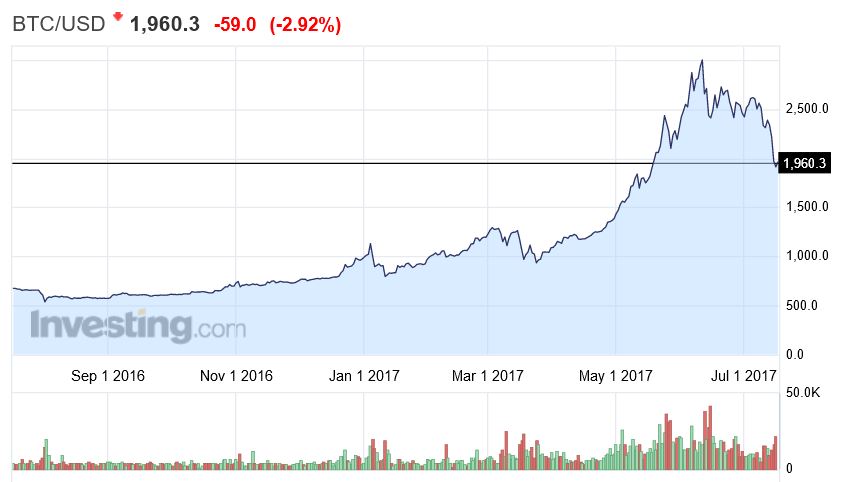Bitcoin has taken a bath, down 24% in a week. What goes up, comes down…
Category: Digital Disruption
Tic:Toc launches with 22-minute home loan
A new fintech Tic:Toc has emerged offering ‘instant home loans’ through a digital real-time loan processing system that connects customers directly to the lender.
CEO Anthony Baum told Australian Broker that in 2015 emerging digital lending capabilities inspired him to formulate and create an instant loan process.
Forming a partnership with Bendigo and Adelaide Bank last year, Tic:Toc will launch today (11 July) with the firm spending the last two years validating the idea and developing the platform.
As for the name, “it’s about time,” Baum said.
“What we saw was an opportunity for a customer to complete a home loan application and be fully approved – and in the case of a refinance even receive their full mortgage documentation – in the same timeframe it would take them to complete an application normally.”
This speed is acheived by decision-making and validation processes that work in real-time with document generation for refinancing done in “close to real-time,” he said.
“It will take approximately 22 minutes to complete the application online. The actual processing of that application is instant and will create a fully approved home loan.”
The system build ensures Tic:Toc remains compliant with legislative requirements such as Know Your Client and responsible lending while following the underwriting parameters agreed to with Bendigo and Adelaide Bank, Baum said.
“What we’ve done is digitalised all of those aspects through the customer application journey and our digital decisioning and validation platforms. At the end of the process, we are in the position to fully assess you and give you an on-the-spot answer.”
Customers will access the platform directly through Tic:Toc’s website which combines property eligibility algorithms, serviceability requirements, responsible lending processes and digital ID and financial validation.
“At the end of that process, you will get a response whether you’ve been approved, declined or referred. If the customer is approved and it’s a refinance, we will send through the documentation in as little as a few minutes. Sometimes it can take a bit longer depending on which state the client lives in.”
If the customer is referred, this means there are factors about the loan that need to be double checked, he added. This will take around 15 minutes to process, after which the application will get either approved or declined.
The service is targeted at eligible customers who meet Tic:Toc’s platform requirements: primarily borrowers in major cities and regional centres with over 20% equity in the property at launch.
“For those customers, it’s all direct. There is no broker access. Customers have a choice – they go to a broker, they can go to a bank branch, or they can get their home loan approved or refinanced online in 22 minutes.”
Tic:Toc also has plans to partner with more banks in the future.
“Bendigo and Adelaide Bank has been a fantastic partner but our intention is to partner with other banks to offer the same experience to their customers as well.”
Baum said that once the fintech branches out to other banks, assessing customer suitability will depend on the model chosen.
“If we offer a choice of brand and product at the front-end, that would be done through a product selection algorithm we’ve got in place. Alternatively if it is just under the same model as we run with Bendigo, it would effectively be the same process that any mortgage manager would run today, whereby they allocate the customer based on the same set of credit parameters. The only thing that would be different is the lender of record because it would be assessed under the same process.”
Baum concluded, saying it was about time home loans came up to speed in terms of process.
“I think the reality is that a lot of the processes and business practices in home loans are very outdated. They create a lot of time and cost wastage that today’s existing technology can eliminate. We’re looking forwards to passing the benefits of that onto customers in the Australian public.”
The Need For Granularity
An interesting working paper from the IMF “Financial Stability Analysis: What are the Data Needs?” looks in detail at the information which is required to enable regulators to understand the dynamics and early warning signs of risks to financial stability. They argue we need to get granular, and think more about “micro-prudential”. Macro-prudential is not enough. In essence, they say that whilst aggregate data may paint an acceptable picture, it can mask significant pockets of risk which are only revealed by going granular. They also call out a wide range of data gaps, from shadow banking to capital flows.
The growing incidences of financial crises and their damage to the economy has led policy makers to sharpen the focus on financial stability analysis (FSA), crisis prevention and management over the past 10–15 years. The statistical world has reacted with a number of initiatives, but does more need to be done? Taking a holistic view, based on a review of experiences of policy makers and analysts, this paper identifies common international threads in the data needed for FSA and suggests ways to address these.
While there has been an encouragingly constructive response by statisticians, not least through the G-20 Data Gaps Initiative, more work is needed, including with regard to shadow banking, capital flows, corporate borrowing, and granular data. Further, to support FSA, the paper identifies potential enhancements to the conceptual advice in statistical manuals including with regard to foreign currency and remaining maturity.
Specifically, they highlight the need to understand, at a granular level the debt profile of households and companies. We agree especially as we have significant data gaps in the Australian context, with regulators relying on relatively high-level, myopic and out of data information. Worse still many banks themselves do not have the granularity they need, so even if regulators asked for more precision, it would not be forthcoming. And confidentiality is an often used shibboleth.
Time to get granular!
To meet the need for increased availability of granular data not only could the collection of more granular data be considered but more use could be made of existing micro data (data that are collected for supervisory or micro-prudential purposes).
Other initiatives to strengthen financial institutions’ risk reporting practices include data reporting requirements arising from the implementation of Basel III and the Solvency II rules; the development of recovery and resolution plans by national banking groups; and the efforts to enhance international financial reporting standards. In addition to contributing to financial institutions’ own risk managements, the improvements in regulatory reporting can contribute to the quality of the more aggregate macro-prudential data for the assessment of system-wide financial stability risks at the national, regional, and international levels.
However, the use of micro data for macro financial assessment has its challenges, the most important being the strict confidentiality requirements associated with the use of micro data. Such requirements typically limit data sharing among statistical and supervisory agencies, and with users. But also granular information brings data quality and consistency issues that need to be dealt with to be able to draw appropriate conclusions for macro-prudential analysis. Tissot points out the importance of being able to aggregate micro information so it can be analyzed, and communicated to policy makers while on the other hand the “macro” picture on its own can be misleading, as it may mask micro fragilities that have system-wide implications.
Macro-stress testing is a key tool to assess the resilience of financial institutions and sectors to shocks and would benefit from more detailed information particularly for the top-down stress tests.
Another area where better data are needed to assess financial stability risks is related to the monitoring of the household sector. Such data include comprehensive information on the composition of assets and liabilities, and household income and debt service payments. Further, the growing interest of policy makers in the inequality gap (i.e., of consumption, saving, income and wealth) has led to a demand for distributional information.
Note: IMF Working Papers describe research in progress by the author(s) and are published to elicit comments and to encourage debate. The views expressed in IMF Working Papers are those of the author(s) and do not necessarily represent the views of the IMF, its Executive Board, or IMF management.
BOE Fintech Accelerator Shows Promise
The Bank of England published summaries of the third round of Proofs of Concept (POCs) completed by its FinTech Accelerator. It nicely shows some of the potential innovation applicable to the finance sector.
The FinTech Accelerator was set up a year ago to deploy innovative technologies on issues relevant to the Bank’s mission and operations. Working in partnership with FinTech firms the Bank is seeking to develop new approaches, build its understanding of these new technologies and support development of the sector.
The latest PoCs covered four important areas of the Bank’s work: analysing large-scale supervisory data sets; executing high-value payments across currencies and borders; identifying and applying cross-cutting legal themes from regulatory enforcement actions; and measuring performance on the Bank’s internal projects portfolio.
Further details on each project can be found in the individual write-ups, but in summary:
- We worked with Mindbridge Ai, a machine learning and artificial intelligence firm, to explore the analytical value of using artificial intelligence tools to detect anomalies in supervisory data sets. Using a sample set of anonymised reporting data, we found Mindbridge’s user interface to be intuitive, allowing the user to explore a time series of each variable, whilst comparing the results to industry averages. This PoC enabled our internal team of data scientists to compare and contrast their own findings and the underlying algorithms being used, providing a complementary layer to the Bank’s work.
- In our PoC with Ripple, we looked into how distributed ledger technology (DLT) could be used to model the synchronised movement of two different currencies across two different ledgers, as part of the Bank’s wider research into the future of high-value payments. Although the Bank has already concluded that DLT is not sufficiently mature to support the core RTGS system, the learnings from this exercise with Ripple have reinforced the Bank’s intention to ensure its new RTGS system is compatible with DLT usage in the private sector, and has highlighted areas where we would like to conduct more exploratory work.
- We worked with Enforcd, giving a group of staff from our Regulatory Action Division (RAD) access to a cloud-based database of regulatory enforcement actions with supporting commentary and trend analysis. Having easy access to relevant published regulatory enforcement decisions can be an important input to financial firms’ overall compliance programmes. This PoC demonstrated how technology could potentially facilitate compliance and the development of best practice in some key areas of regulation.
- Lastly we ran a proof of concept with Experimentus, using their ORB tool, to analyse historic Bank of England projects and visualise how they had performed against a range of standard key performance indicators (KPIs). This PoC allowed us to explore whether our existing test data were sufficient to carry out effective KPI reporting, and where further data collection might be needed.
Commenting on these latest POCs, Andrew Hauser, Executive Director for Banking, Payments and Financial Resilience, said:
“We have learnt a great deal through these latest Proofs of Concept, both in terms of what FinTech can do, but in also in terms of how it can help us work, think and communicate differently. The breadth of topics covered by these projects, and the Accelerator programme as a whole, shows how much central banks potentially have to gain from continued engagement with the sector in delivering their mission of monetary and financial stability.”
The Accelerator invited applications for its fourth round of PoCs in April 2017 and expects to announce the successful firms shortly.
Find out more about the work of the FinTech Accelerator.
Secured Peer To Peer Lender Launches In Australia
Zagga, chaired by former banking executive Peter Clare and led by CEO Alan Greenstein, held a launch party in Sydney recently.
Zagga was co-founded in Australia by Edwin and Marcus Morrison, who also established LendMe in New Zealand with Mark Kirkland.
Zagga Australia shares a technology platform, back office and administration with Zagga New Zealand.
The firm is looking to differentiate itself from competitor peer-to-peer lenders by pitching itself as the ‘secured alternative’.
All Zagga’s loans are secured against a property and investors are matched with a specific loan, i.e. it is not a ‘pooled’ structure.
While an algorithm is used to match investors with borrowers, depending on each investor’s risk tolerance, each lender undergoes a credit assessment by Zagga’s staff.
Mr Greenstein said Zagga is the first marketplace lender in Australia to hold both an Australian Credit Licence and an Australian Financial Services Licence in its own name.
Zagga expects its loans to generate a net return of at least 8.5 per cent a year, with the tagline “We don’t fund the loans the banks don’t want. Rather, it’s the ones they can’t do”.
“The benefit that Zagga, as an alternative asset class, brings to investors is that they are able to add a ‘middle ground’ to their portfolios, providing regular, consistent income,” the firm said.
“Yet, they benefit from greater capital protection than equities and higher returns than traditional bonds or fixed income products.”
Successful blockchain trial for bank guarantees
ANZ and Westpac have teamed with IBM and shopping centre operator Scentre Group and have now successfully digitised the bank guarantee process used for commercial property leasing.
The trial used Distributed Ledger Technology (DLT) to eliminate the need for current paper-based bank guarantee documents, resulting in a single source of information with reduced potential for fraud and increased efficiency.
The partners involved in the trial have today released a whitepaper detailing how the solution worked and how it could be used in other situations that rely on bank guarantees.
In addition to eliminating the need for physical document management, the trial also addressed other inefficiencies in the current bank guarantee process, including the challenges in tracking and reporting of a guarantee’s status through multiple changes.
This forms part of a broader plan to build a shared solution with the rest of the industry, and to invite other organisations to participate in a larger pilot.
Commenting on the successful trial, Mark Bloom, Chief Financial Officer at Scentre Group, said: “An update of the decades-old process for issuing, tracking and claiming on guarantees is long overdue.
“With approximately 11,500 retailers across Australia and New Zealand, who use guarantees to support rental obligations, manual tracking of guarantees has been an extremely cumbersome and labour intensive process.”
Nigel Dobson, General Manager Wholesale Digital, Digital Banking at ANZ, said: “We have been keen to avoid the hype surrounding blockchain and distributed ledger technologies, and instead focused on practical and deliverable use cases.
“This proof of concept demonstrates how we can collaborate with our partners to develop a digital solution for customers, which also has the potential for industry-wide adoption.”
Andrew McDonald, General Manager Corporate and Institutional Banking at Westpac, said: “This is about removing the cost of fraud, error and operational risk that will continue as long as bank guarantees remain paper-based and manually issued.
“Next steps involve encouraging all industry players to adopt this technology so we can better protect and save money for our customers. Beyond that there is no reason why this couldn’t be applied across other industries.”
Dr. Joanna Batstone, Vice President and Lab Director of IBM Research Australia, said: “Using an agile approach, IBM collaborated with ANZ to combine the bank’s deep knowledge of the industry and their partners, with IBM’s blockchain expertise.
“The business use case demonstrates the opportunity to lift efficiency and transparency for all parties involved. We believe blockchain can potentially drive productivity across all Australian industries.”
This blockchain trial used Distributed Ledger Technology (DLT) powered by Hyperledger Fabric V1.0 – a blockchain framework and one of the Hyperledger projects hosted by The Linux Foundation. You can view the whitepaper.
Fintechs warn Domain and REA of mortgage ‘challenges
Two mortgage fintechs have warned that the REA Group and Domain, as well as customers and brokers, could face ‘challenges’ as a result of the property companies’ forays into mortgages.
Last week, both the REA Group and Domain Group revealed plans to break into mortgage broking, with realestate.com.au acquiring a majority stake in mortgage broking franchise business Smartline and entering into a strategic mortgage broking partnership with NAB. Likewise, the Fairfax-owned property classified group announced that it will launch Domain Loan Finder, in partnership with mortgage platform Lendi.
However, Mandeep Sodhi, CEO of online brokerage HashChing, has suggested that the new offerings from Domain and realestate.com.au could upset the market.
He said: “[These sites] have traditionally been seen as helpful, independent websites for consumers to research their next dream home or investment property. However, the most recent partnerships by both with mortgage broking platforms has the potential to restrict choice in the market.
“Pushing borrowers to one group of brokers – who may not have access to all the banks and lenders – means they could unwittingly miss out on home loan products that better suit their needs.”
Mr Sodhi added that brokers could be negatively affected, as the two sites had historically been “strong sources for generating leads for aggregators to date” and brokers who aren’t members of the partnered mortgage broking platforms would have to therefore find new lead sources.
Likewise, the founder and CEO of online brokerage uno. has suggested that while the move by Domain and REA’s realestate.com.au site is “logical”, the companies could face “challenges” while breaking into the mortgage arena.
Speaking to The Adviser, Vince Turner explained: “These guys have a lot of eyeballs, a big audience, and their traditional line of business in terms of advertising [such as website advertising via cost per click] is now going into the nominal value territory. They are not on the way out yet, but they will be soon.
“So, from Domain or REA’s point of view, they have to think what their transactions are that they can monetise … So, you can see why they want to get into transactional mortgages, that’s the logical part.”
However, Mr Turner warned that breaking into a new industry (i.e. mortgages) is not only challenging from a cultural perspective, but also from a customer buy-in perspective.
He explained: “You could argue that it’s pretty hard to get out of bed in the morning and be a media company [publishing company Fairfax owns Domain] and a financial services company. It’s very different culturally and it’s a very different set of skills, so I think that will be part of the challenge… These things are not natural to them.”
The uno. founder said that his company had partnered with several different companies, but that the thinking was that these partnerships would only be around 10 or 20 per cent of its business.
He said a large part of the difficulty would be getting customer buy-in, as users of the realestate.com.au and Domain are not primarily visiting the sites for a mortgage, but for a property listing/rental listing.
“It’s difficult to get a consumer to get onboard with a something that is not what they went to the site for. For example, they are using the sites for real estate, not a mortgage, so it’s challenging to get them onboard with this new side,” Mr Turner said.
“We know it’s challenging because we have been working real estate sites and we operate with other sites that want to bundle mortgages into their consumer experience … [if] the customer didn’t go there for a mortgage, trying to intercept them and say ‘Look at this mortgage over here’, it’s difficult.”
Another obstacle that these sites could face is the customer service side of handling a mortgage, Mr Turner said.
“Consumers who are going to these sites are operating digitally, so convincing them to go through the mortgage process, which needs ‘advice’, is challenging,” he said.
Mr Turner revealed that delivering that support and ‘advice’ had been a challenge for uno. and explained that, although he believes the online brokerage is “leading this space in delivering an advice experience and the support experience digitally”, it had spent the last year trying to solve this conundrum and “still has a long way to go”.
“I think it’s going to be a long road for Domain and REA in getting this to work for them,” he added.
“I think they have the pockets to push it and they have made it a strategic priority (and maybe they will get there in the end), but its not as simple as just bolting on a mortgage broking business. It’s a lot more complicated than that.”
Xpress Super and RateSetter announce integration to boost SMSF access to peer-to-peer lending
RateSetter, Australia’s largest retail peer-to-peer lender, has today announced a partnership with innovative self-managed super fund (SMSF) administration provider, Xpress Super.
The integration provides investors with direct access to their RateSetter account on the Xpress Super platform, making it easier for SMSF investors to earn attractive returns by lending to creditworthy borrowers via RateSetter’s award-winning platform.
Olivia Long, CEO of Xpress Super, says: ““Two of the key benefits of running an SMSF is the ability to select your own investments as well as invest in financial products not accessible with other superannuation vehicles. This is exactly what RateSetter allows SMSF trustees to do.”
Since RateSetter was established in Australia in 2014, the company has facilitated more than $130 million in loans through its platform with SMSFs providing the funds for more than 20% of those loans.
Daniel Foggo, CEO of RateSetter Australia, says: “Given the historical low cash rates and uncertainty in property and equity markets, there is a real shift in where SMSFs are looking to invest. With returns of up to 9.2% a year and our exceptional track record both here and in the UK, we expect to see continued growth from SMSF investors seeking stable, attractive returns.
“Until now, investing in consumer and small business credit has been an option only available to a privileged few, including large wholesale investors and the banks.
“By working with partners such as Xpress Super, we’re giving SMSF investors an easy, simple-to-manage option to access this attractive, established asset class.”
Long says that there is a natural fit between RateSetter and Xpress Super. “RateSetter and Xpress Super have a shared belief in the importance of transparency, control and delivering value to investors.
“Xpress Super’s automated, paperless platform gives investors live, up-to-date information, helping them make informed decisions about their superannuation investments and simplifying their year-end accounting, and this service extends to new investment classes, such as peer-to-peer lending.”
Fintech Disruption of Personal Credit Gains Pace
I caught up with Clayton Howes, CEO of MoneyMe to explore in more detail the development of this Fintech which recently announced it had broken the $100m loan barrier (and has steamrolled past $125m since our conversation); all outside the traditional banking network.
Founded in 2013, with a pool of private investors, MoneyMe it is a great example of the innovation enabled by technology, building from the consumer in and leveraging the digital savvy behaviour of target consumers. It highlights why disruption is coming to the finance sector, and why we find the emergence of Fintech’s so significant.
The segment of the market in which they are operating is the $60 billion unsecured consumer finance sector, dominated by players like Latitude. GE Capital sold its local business to a consortium including Varde Partners, KKR and Deutsche Bank at an enterprise value of A$8.2bn, and renamed it Latitude in 2015.
But Clayton highlights the fact that MoneyMe has been set to differentiate, with the clear goal of making finance more easily accessible for young digitally aware millennium consumers. Take the example of a 26-year-old seeking to purchase a second hard car and needing $5,000 for 2 years. He would find the banks are not be interested, as the term and size is too low to be economically sustainable for them. He might put the loan on a credit card, but with a high interest rate, and the risk that credit on the card would be too tempting – many millennials are wary of credit cards. He might go to finance players offering loans at high rates and with limited flexibility.
So the MoneyMe offer is a fixed rate structured loan with standard and predictable repayments, most often paid by monthly direct debt. Through the online portal, borrowers can make changes to their repayment schedule, for example, delay payment one week and make two the next. Transparency is the watchword.
Behind the scenes, applications are screened and scored using a risk-based pricing model, including using the Equifax score, actuarial algorithms, behaviour patterns, and information from bank statements. The pricing of loans varies based on this extensive data rich analysis, but Clayton said that in many cases the charges will be lower than other providers, and easier to understand. And that’s the point; the core proposition is “What You See IS What You Get”. Some other finance providers add on various fees and charges, which makes it hard to see what the total costs of borrowing are.
The online “slider” form is intuitive and easy to use, and it recalculates the indicative APR each time. Those with adverse credit will pay more, as expected. Consumers can choose to make repayments weekly, fortnightly or monthly. The application process is also simple and swift.
 Interestingly the sweet spot for the business is a $5,000 over two years, but potential borrowers have the capacity to select a smaller loan for a shorted period, so touching on the SACC market, or a larger for longer loan of up to 3 years and $10,000. Should consumer want to borrow again subsequently, they have to apply again.
Interestingly the sweet spot for the business is a $5,000 over two years, but potential borrowers have the capacity to select a smaller loan for a shorted period, so touching on the SACC market, or a larger for longer loan of up to 3 years and $10,000. Should consumer want to borrow again subsequently, they have to apply again.
Default rates are contained, ranging between 2 and 4 per cent, which is significantly below the industry average. They have written more than 100,000 loans already, and growth is accelerating.
The company is also growing fast, with 42 employees, and big plans to expand into other financial products.
As we said recently, MoneyMe is a good example of the innovative new players pressing in on existing lenders with digitally sassy offerings to target market segments. We expect more disruption in the months ahead.
Our surveys underscore the strong demand for finance from niche segments, despite overall personal credit falling according to recent RBA data.
Domain announces broking joint venture
Domain Group has announced it is expanding into home loans broking with the launch of ‘Domain Loan Finder’ in partnership with digital home loan platform Lendi.
Domain Loan Finder, launching in early July, is set to become a key digital solution for customers in Australia looking to secure a home loan. It offers consumers a simple and stress-free online process to connect with more than 30 leading lenders, including major banks, coupled with access to a national community of home loan specialists for personalised help and expert advice.
Domain chief executive officer, Antony Catalano, said: “This is a very important strategic announcement for Domain, and means we are the first major real estate listings portal to move beyond helping our audience find a home to helping them secure a home. Domain will be Australia’s first end-to-end property search and finance platform.
“Lendi is a fast-growing consumer brand with a superior product offering, and we are very excited that Lendi will be powering Domain Loan Finder to help Australians secure the best home loan available to them.
“Domain Loan Finder helps consumers apply for loans that are genuinely available in the market – it is not just another rates comparison website.
“We expect Domain Loan Finder will quickly become a must-use and valuable digital tool for all Australians looking to secure a home loan. We will actively market our home loan solution to our large and highly engaged audience of more than 4 million a month in a highly relevant, personalised and timely way.
“Domain is well positioned to utilise its popular consumer technology platforms to enter into a partnership in the Australian home loan broking market, which generates about $2bn a year in commissions, and to expand beyond its current home loan lead referral business.
“This new offering is part of the full complement of real estate products and services that Domain is building out to deliver on the modern needs of today’s property buyers, owners and sellers, as well as to grow new transactional revenues.
“Domain Loan Finder adds to Domain’s other investments in utilities connections business Compare & Connect, home improvement and maintenance business Oneflare, and open for inspection check-in management system Homepass.
“We are very much looking forward to working with Lendi to pursue this significant opportunity to continue to create value through digital innovation for audiences and customers.”
Lendi managing director, David Hyman, said: “We’re excited to be working with Domain to bring the Lendi experience to a wider audience.”
“Tapping into Domain’s strong market position, we’re looking forward to bringing an integrated home loan experience to the property buying process.
“With more and more consumers turning to online channels as part of their home loan research, there’s a huge opportunity to enhance that journey with contextual and relevant engagement as they progress through the property buying journey.”
Domain Loan Finder will operate as a joint venture with Lendi’s parent entity, Auscred, with Domain holding a 60% stake. The amount invested in the JV is not material and remains confidential.
Lendi started in 2013 as an online and phone-based broking business and is backed by major institutional investors and venture capital.








